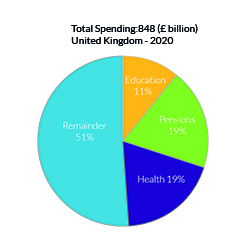NHS and Social Care Funding – How is the money distributed?
20 Jan 2020 |
| Share with

Since the launch of the National Health Service – NHS – back in 1948, the UK has enjoyed free health care at the point of service for all. But, as the population increases and people are living longer lives, a certain strain is placed on the financial underpinnings of this British institution. Now more than ever the NHS needs to distribute its wealth wisely to meet rising demands.
Let’s look at where the money comes from and where it goes within this national institution that is the NHS.
Where does the NHS receive its funds from?
Funding for health services comes from the total budget for the Department of Health and Social Care (DHSC). In 2020 the UK governments are predicted to spend almost 40% of the gross domestic product -GDP. Most of this is distributed between big guns-health care, education, pensions, and social welfare.
So, where does this funding originate from? Finances are provided mostly through –
- Taxation (80%).
- National insurance contributions.
- A lessor amount comes in through patient charges, for example, prescriptions and dental care costs.
How does the NHS spend?
The NHS receives its funding, so how does it spend it? Well, looking to the immediate past, in 2017/18, approximately £110 billion was spent on the NHS England budget. 1
Main areas for expenditure include:
- Day to day running of the NHS – such as staff salaries, medicines, etc.
- Public health initiatives – to improve public health, therefore fewer patients will need the NHS
- Training
- Education
- Infrastructure – building hospitals and IT 2
The pie chart (Figure 1), below illustrates the percentage of spending on health care in the UK.
At 19%, it is costing the UK economy approximately one-fifth of the total national budget.3

Figure 1: Illustrated the percentage of total spending in the UK on health at 19%.
Social care funding and the NHS– Is the model of social care provision very different from that of the NHS? The short answer is yes, quite different funding strategic processes are involved. The NHS care is free, but publicly funded adult social care is means-tested and mainly funded through local government. However, the link between the sustainability of the NHS and the adult social care is fundamental, meaning that the financial provision for both systems cannot be considered in isolation from one another.4
What does the future hold financially for the NHS?
Brighter days ahead? Well, £20 billion of additional funding for the NHS in England will certainly help. This will be spread out over five years to 2023/24. This kind of monitory enhancement will be advantageous to the evolvement of the NHS and ultimately to quality care for patients, who are after all, what it is all about.
At the heart of many communities, the NHS has and will continue to, serve quality care delivered by expert professionals, as it looks forward to a new year filled with possibilities!

Figure 2: The above illustration highlights the financial flow within the NHS. 5
References

20 Jan 2020 | Leave a comment
Share with socials